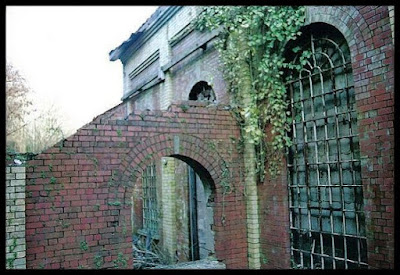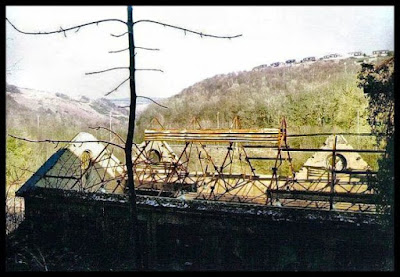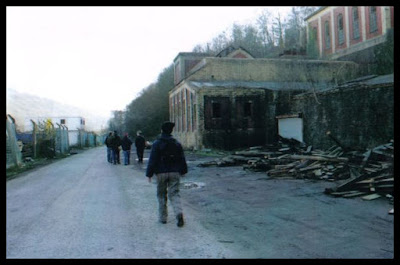Apart from the Updates post and the Navigation Mine, which was the last part of the South Wales explore articles started in November, I've decided to kick-start the year with something fun and quirkily different. This one wasn't on my late website, as I didn't intend to do anything with the photos at the time, but I've since taken more along with gleaning some information, so here goes...
In early Spring 2007 I took some outside photos of Racals Electronics and decided to investigate a tiny lane nearby. It led down to these huts. I didn't know what they were for at first until I heard a soft cooing coming from inside, when I realised they were pigeon lofts. I was quite excited as I'd never seen any before, thinking that pigeon lofts were usually in actual lofts - which many are - but doing a google search produced images of many different kinds, including some like these.
At one time there used to be a lot of domestic pigeons flying around the buildings first thing in the morning where I live. It was quite a sight to see them fly past the windows on their circular journey round. Not any more, although there's the lovely mournful song of collared doves coming from nearby trees. Domestic pigeons were bred from the domesticated descendants of the rock dove and are quite distinct from the smaller, pretty collared doves and colourful wood pigeons, which are now more commonly seen in the trees of our parks and gardens.
Pigeon breeders are commonly referred to as pigeon fanciers, choosing from hundreds of breeds which have been cultivated from their common ancestor, mainly for three specific purposes: a) Flying/Sporting, trained for racing and homing, b) Fancy, for shows & competitions, and c) Utility, bred for their meat and for breeding stock.
Pigeon lofts come in all shapes, sizes and designs, as attested by the amount I saw on Google images plus the few different ones I saw here. I haven't been able to discover anything about these lofts at all. They may have belonged to just one person or a few different fanciers sharing the site, the lofts ranging from quite old to fairly new looking.
Kept mostly for food, especially in the winter when other fresh meat wasn't so available, pigeons have been domesticated for around 10,000 years. It's thought that the Romans introduced pigeons to England, housed in columbaria - small buildings containing pigeonholes for nests - from the Latin for columba meaning 'dove' or 'pigeon'.
More commonly called Dovecots or Dovecotes - Doocots in Scotland - it is either a free-standing small building, such as the round one at Avebury in Wiltshire (shown above and the interior below), or built into the fabric of a house or outer building, such as a barn.
Norman castles of the 12th century were the earliest known examples of pigeon keeping in buildings, and many wealthy landowners since have also used them. An example is at Shute Manor in Devon, seen below; the square holes in the wall are situated above the kitchen door as a convenience for the cooks.
We were told a funny story about the previous owner whilst on a guided tour at Shute Manor. Apparently he was so fed up with having pigeons poo on his head whenever he used the kitchen entrance that he had pieces of stone inserted into the holes to stop the pigeons from roosting in them. :)
Back to our Seaton lofts, alongside was this path with low walls either side. A couple of apple trees grew near the end and it was such a peaceful place that I sat on the wall for a while and had a coffee from the flask I'd brought with me. And to top it all, two hares were leaping and chasing each other in the field next door...something I hadn't seen since I was a child. Absolute magic!
Having decided to do something with the photos after all, I had a walk down there a couple of years ago to see what had happened to the lofts since the so-called town regeneration - don't get me started, lol - and found that almost everything was gone.
Even so, it's lovely to have this small reminder of finding these pigeon lofts and enjoying my coffee break in the early Spring sunshine, the apple trees just coming into blossom and the sight of those mad march hares. Magic indeed! :)















































